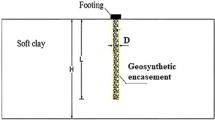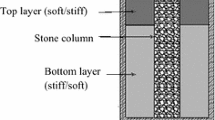Abstract
Ordinary stone column (OSC) reinforced soft soils undergo excessive settlements under vertical stresses due to the lack of adequate lateral support from the surrounding native soil. To overcome this issue, stone columns are suitably encased by a geosynthetic material having high axial stiffness, which provides the required additional confinement. A numerical analysis aimed at analyzing the effect of geosynthetic encasement on the load settlement behavior of geosynthetic encased stone columns (GESC) under vertical stresses is presented. Three dimensional (3D) models were developed in PLAXIS3D to simulate the behavior of stone column reinforced soft soils using the unit cell idealization concept. The numerical models were first validated with the help of experimental data of model tests on GESCs from literature. Various parameters were varied to quantify their impact on the load settlement behavior under column only loaded condition. The parameters varied include the diameter of GESCs, spacing to diameter (S/D) ratio, pattern of stone column installation, geosynthetic encasement stiffness, length of encasement, length of floating column, cohesion of soil and friction angle of stone column infill. Increase in the diameter of GESCs led to increased settlement for a particular vertical load intensity. The bearing capacity improved with increase in the geosynthetic stiffness, encasement length, length of floating GESCs, the cohesion of soil and the friction angle of the stone column infill. Increase in S/D ratio decreased the bearing capacity and triangular pattern of stone column installation was found to be more efficient. Moreover, the lateral bulging indicated a reducing trend upon increasing the axial stiffness of encasement.


























Similar content being viewed by others
References
Aboshi H, Ichimoto E, Harada K, Emoki M (1979) The composer—a method to improve the characteristics of soft clays by inclusion of large diameter sand columns. In: Proceedings of international conference on soil reinforcement, Paris, p. 211–216
Ali K, Shahu JT, Sharma KG (2012) Model tests on geosynthetic- reinforced stone columns: a comparative study. Geosynth Int 19(4):292–305
Almeida MSS, Hosseinpour I, Riccio M (2013) Performance of a geosynthetic encased column (GEC) in soft ground: numerical and analytical studies. Geosynth Int 20(4):252–262
Ambily AP, Gandhi SR (2007) Behaviour of stone columns based on experimental and FEM analysis. J Geotech Geoenviron Eng ASCE 133(4):405–415
Ayadat T, Hanna AM (2005) Encapsulated stone columns as a soil improvement technique for collapsible soil. Ground Improvem 9(4):137–147
Castro J, Cimentada A, Costa A, Canizal J, Sagaseta C (2013) Consolidation and deformation around stone columns: compar- ison of theoretical and laboratory results. Comput Geotech 49:326–337
Chen JF, Li LY, Xue JF, Feng SZ (2015) Failure mechanism of geosynthetic encased stone columns in soft soils under embankment. Geotext Geomembr 43(5):424–431
Dar LA, Shah MY (2020) Deep-seated slope stability analysis and development of simplistic FOS evaluation models for stone column-supported embankments. Transp Infrastruct, Geotech
Ghazavi M, Afshar JN (2013) Bearing capacity of geosynthetic encased stone columns. Geotext Geomembr 38:26–36
Gniel J, Bouazza A (2009) Improvement of soft soils using geogrid encased stone columns. Geotext Geomembr 27(3):167–175
Goughnour RR (1983) Settlement of vertical loaded stone columns in soft ground. Proceedings of the 8th European conference on soil mechanics and foundation engineering, Helsinki 1:23–25
Greenwood DA (1970) Mechanical improvement of soils below ground surfaces. In: Proceedings, ground engineering conference, institution of civil engineers, London, pp 11–22
Han J, Ye SL (2001) Simplified method for consolidation rate of stone column reinforced foundation. J Geotech Geoenviron Eng ASCE 127(7):597–603
Hughes JMO, Withers NJ, Greenwood DA (1975) A field trial of the reinforcing effect of a stone column in soil. Geotechnique 25(1):31–44
Indraratna B, Bamunawita C, Khabbaz H (2004) Numerical modelling of vacuum preloading and field applications. Can Geotech J 41(6):1098–1110
IS: 15284 (part 1) (2003) Indian standard code of practice for design and construction for ground improvement—guidelines. Indian Standards Institution, New Delhi
Keykhosropur L, Soroush A, Imam R (2012) 3D numerical analyses of geosynthetic encased stone column. Geotext Geomembr 35(2012):61–68
Khabbazian M, Kaliakin VN, Meehan CL (2010) Numerical study of the effect of geosynthetic encasement on the behaviour of granular columns. Geosynth Int 17(3):132–143
Khadhim ST, Parsonsn RL, Han J (2018) Three dimensional numerical analysis of individual geotextile encased sand column with surrounding loose sand. Geotext Geomembr 46:836–847
Malarvizhi SN, Ilamparuthi K (2007) Comparative study on the behaviour of encased stone column and conventional stone column. Soils Found 47(5):873–885
Mohanty P, Samanta M (2015) Experimental and numerical studies on response of the stone column in layered soil. Int J Geosynth Ground Eng 1:1–14
Murtaza H, Samadhiya NK (2016) Experimetal and numerical analysis of geosynthetic-reinforced floating granular pies in soft clays. Int J Geosynth Ground Eng 2:22
Murugesan S, Rajagopal K (2006) Geosynthetic-encased stone columns: numerical evaluation. Geotext Geomembr 24:349–358
Murugesan S, Rajagopal K (2007) Model tests on geosynthetic encased stone columns. Geosynth Int J 24(6):346–354
Najjar SS, Sadek S, Maakaroun T (2010) Effect of sand columns on the undrained load response of soft clays. J Geotech Geoenviron Eng ASCE 136(9):1263–1277
Priebe HJ (1995) The design of vibro-replacement. Ground Eng 28(10):31–37
Pulko B, Majes B, Logar J (2011) Geosynthetic-encased stone columns: analytical calculation model. Geotext Geomembr 29(1):29–39
Rajagopal K and Mohanty SR (2016) Behaviour of geosynthetic encased granular columns under vertical and lateral loading. In: 6th Asian regional conference on geosynthetics
Rajasekaran G, Rao SN (2002) Compressibility behaviour of lime treated marine clay. Ocean Eng 29(5):545–559
Rampello S, Callisto L (2003) Predicted and observed performance of an oil tank founded on soil-cement columns in clayey soils. Soils Found 43(4):229–241
Sharma SR, Phanikumar BR, Nagendra G (2004) Compressive load response of granular piles reinforced with geogrids. Can Geotech J 41(1):187–192
Shen SL, Chai JC, Hong ZS, Cai FX (2005) Analysis of field performance of embankments on soft clay deposit with and without PVD-improvement. Geotext Geomembr 23(6):463–485
Van Impe W, Silence P (1986) Improving of the bearing capacity of weak hydraulic fills by means of geotextiles. In: Proceedings of the 3rd international conference on geotextiles, Vienna, pp 1411–1416
Wu CS, Hong YS (2009) Laboratory tests on geosynthetic encapsulated sand columns. Geotext Geomembr 27:107–120
Yoo C (2010) Performance of geosynthetic-encased stone columns in embankment construction: numerical investigation. J Geotech Geoenvir Eng ASCE 136(8):1
Yoo C, Lee D (2012) Performance of geogrid-encased stone columns in soft ground: full-scale load tests. Geosynth Int 19(6):480–490
Author information
Authors and Affiliations
Corresponding author
Ethics declarations
Conflict of interest
The authors declare that there is no conflict of interest in publishing this research.
Additional information
Publisher's Note
Springer Nature remains neutral with regard to jurisdictional claims in published maps and institutional affiliations.
Rights and permissions
About this article
Cite this article
Dar, L.A., Shah, M.Y. Three Dimensional Numerical Study on Behavior of Geosynthetic Encased Stone Column Placed in Soft Soil. Geotech Geol Eng 39, 1901–1922 (2021). https://doi.org/10.1007/s10706-020-01594-x
Received:
Accepted:
Published:
Issue Date:
DOI: https://doi.org/10.1007/s10706-020-01594-x




